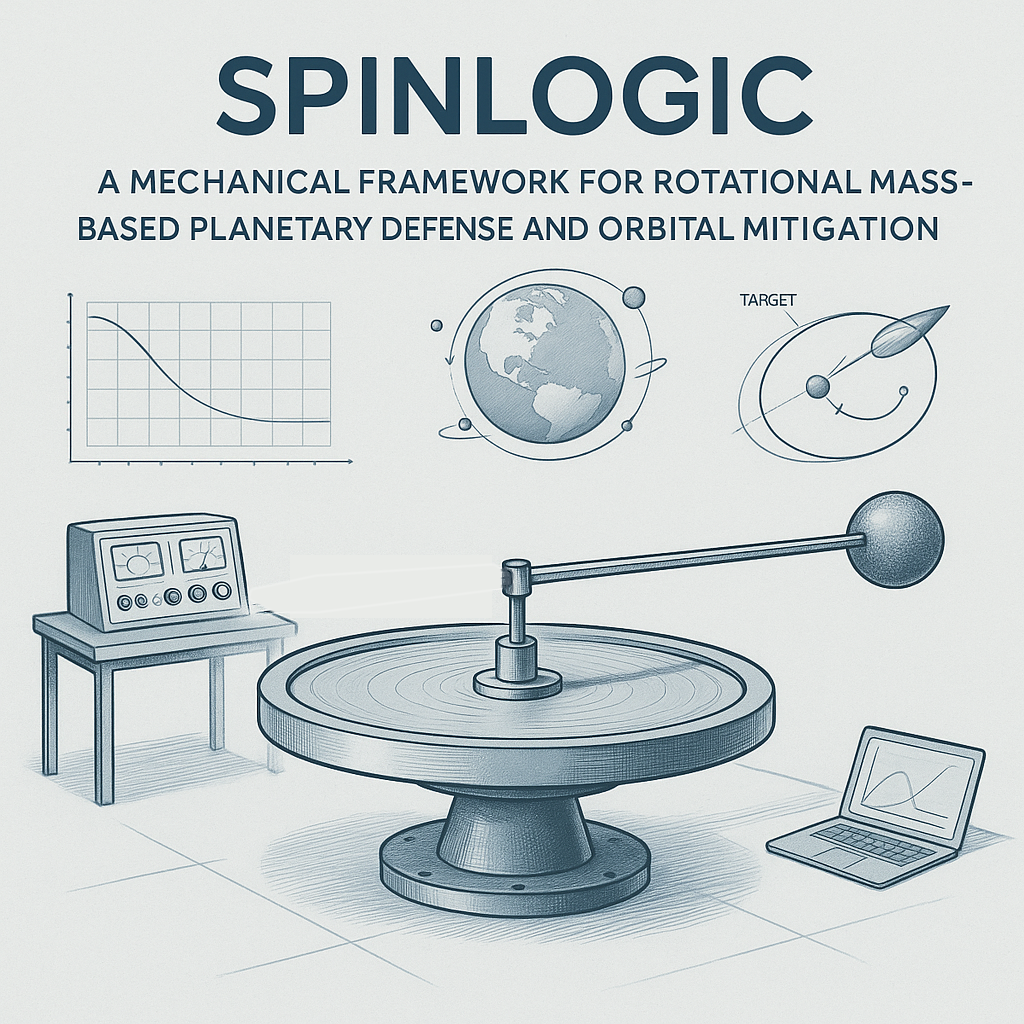SpinLogic – A Mechanical Framework for Rotational Mass-Based Planetary Defense and Orbital Debris Mitigation

Abstract
This paper introduces a modular approach to planetary defense and orbital hygiene using rotational mass dynamics. Four variations are explored:
(1) a ground-based tether-release system using Earth’s rotation,
(2) autonomous high-orbit kinetic release satellites (SpinFence),
(3) micro-scale orbital cleanup units (MISATs), and
(4) a tether-based vertical debris harvester for long-range orbital collection (Tether Collector System).
Each design is rooted in low-energy mechanical principles, maximizing scalability, autonomy, and cost-efficiency while minimizing reliance on propulsion or explosive technologies.
1. Earth-Based Rotational Catapult System
Long tethers or cables (300–400 km in length) are mounted at four equidistant strategic locations around the Earth’s surface. Attached to the ends of these tethers are kinetic masses. These rotate along with the Earth’s surface due to planetary rotation. If an incoming meteor is detected, one or more of these masses can be released at precisely calculated moments. The rotation of the Earth imparts substantial linear velocity to the mass, and upon release, the object follows a ballistic tangential path toward the meteor. No propulsion is needed—only precise timing.
2. Autonomous Orbital Rotational System (SpinFence)
Large satellites placed in high Earth orbit carry one or more rotating masses tethered or rail-mounted. Rotation is sustained through solar-powered flywheel systems. Upon identifying an impact threat, the satellite releases a mass (or two, for balance) at an exact angle and moment. This mechanical solution bypasses the need for propulsion and relies solely on stored angular momentum.
3. MISAT – Micro-Satellites for Orbital Debris Removal
Compact one-meter cube satellites equipped with dense steel or tungsten spheres orbit Earth. Using onboard AI, they track debris and release projectiles with precise timing to alter debris orbits toward atmospheric burn-up. A fleet of 100 such satellites with 1,000 spheres each could clean critical orbit regions in months. The system is low-cost, scalable, and uses no propellant.
4. Tether Collector System – Reusable Vertical Debris Harvester
Based on concepts derived from space elevator research, this system uses ultra-strong tethers suspended from the upper atmosphere into low Earth orbit. Along these tethers, small, automated collector units travel upward, equipped with magnetic arms, mesh cages, or precision claws. Once in orbit, they capture nearby debris and return downward along the same tether to offload material into Earth-based recovery stations. This method allows cyclical reuse of both the collector vehicles and tether infrastructure. The system is mechanical, energy-efficient, and scalable for continuous operation without the need for onboard propulsion.
Suggested Future Applications
- Autonomous orbital construction using kinetic energy transfer
- Space elevator tethered mass balancing
- Interplanetary cargo acceleration by staged rotational release
- Deep-space mining debris deflection using passive systems
- Debris-to-material conversion modules for in-orbit manufacturing
Disclaimer This concept is part of the Pointless Science Center initiative, an open thought laboratory for radical, speculative, and creative engineering outside conventional research pathways. While grounded in real physics, implementation is theoretical and intended to inspire discussion and innovation.
References
- Kessler, D.J., Cour-Palais, B.G. (1978). Collision frequency of artificial satellites: The creation of a debris belt. Journal of Geophysical Research, 83(A6), 2637–2646.
- ESA Space Debris Office (2023). Annual Space Environment Report. https://www.esa.int/Safety_Security/Space_Debris
- W. M. Folkner et al. (2014). The Planetary Ephemeris DE430 and DE431. Jet Propulsion Laboratory.
- P. Jaffe & D. McSpadden (2007). Energy Conversion for Space-Based Kinetic Defense Systems. IEEE Transactions on Aerospace and Electronic Systems.
- Oberth, H. (1929). Wege zur Raumschiffahrt. Oldenbourg Verlag.
Keywords Planetary defense, orbital debris, kinetic interceptor, rotation mechanics, micro-satellites, SpinFence, orbital cleanup, tether systems, debris recovery, mass ejection system
Author: S. [Redacted], Pointless Science Center Initiative
Published: June 2025 | NovaPort Series, Volume 001
